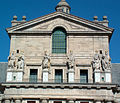Juan de Herrera
Juan de Herrera | |
|---|---|
 | |
| Born | 1530 |
| Died | January 15 1597 |
| Alma mater | University of Valladolid |
| Occupation | Architect |
| Buildings | El Escorial Royal Palace of Aranjuez Valladolid Cathedral |
Juan de Herrera (1530 – January 15, 1597) was a Spanish architect, mathematician and geometrician.
One of the most outstanding Spanish architects in the 16th century, Herrera represents the peak of the Renaissance in Spain. His sober style was fully developed in buildings like the Monastery of San Lorenzo de El Escorial. The Herrerian style was named after him, and was representative of the architecture of the Spanish Empire of Philip II and his Austrian successors.
As a Renaissance man, Herrera was interested in all the branches of knowledge of his times. His Discurso sobre la figura cúbica (Speech of the Cubic form) tells us about his notable knowledge about geometry and mathematics. He also participated in the military campaigns of Charles V in Germany, Flanders and Italy.
Biography
Juan de Herrera completed his studies at the University of Valladolid in the spring of 1548. He started his architectural career in 1561 with the works in the Royal Palace of Aranjuez.
In 1563 he starts his collaborations with Juan Bautista de Toledo in the construction of El Escorial. In 1562 he had written the Book of the Astronomical knowledge (Libro del saber de astronomía). After the death of Juan Bautista de Toledo in 1567, Herrera becomes the director architect of the works. Herrera modifies the plans and enlarges the program, changing the image of the façades and introducing his personal sober style. The main keys of his design are the impressive horizontal unified composition and the nude use of the granite, omitting the classical orders for large surfaces.
He builds the monumental western façade, the Basilica with its central composition plan and the pavilion of the Patio de los Evangelistas (Court of the Evangelists). He also modifies the constructive techniques and the roofing. This style introduced in the monastery influenced Spanish architecture for over a century with the name of Herrerian style.
The plans of the Cathedral of Valladolid and the Archivo General de Indias were also designed by him. He was the first original designer for the Plaza Mayor in Madrid.
Main works

- Palacio Real de Aranjuez (1561).
- Monasterio de El Escorial (1563).
- Palacio de El Quexigal (1563), building since disappeared, built in Robledo de Chavela, (Madrid).
- South Façade of the Alcázar de Toledo (1571–1585).
- Casa Consistorial de Toledo (1575).
- Puente de Segovia in Madrid (1582-1584).
- Design of the Lonja de Sevilla, current Archivo de Indias (1583).
- Catedral de Valladolid (1589).
- Real Aposento de Torrelodones (1589), building since disappeared, built in Torrelodones.
Gallery
-
El Escorial, by Juan Bautista de Toledo and Juan de Herrera.
-
Valladolid Cathedral
-
Façade of the Monastery of El Escorial
-
Detail of the Court of the Kings, in El Escorial.
-
Dome of the Basilica of El Escorial
-
Houses in front of the Monastery of El Escorial.
-
Archivo de Indias, Seville
-
Model of the project of Herrera for the Cathedral of Valladolid.








